Pablo Serrano 1908-1985. A traveller’s footprints
|
Pablo Serrano 1908-1985
A traveller’s footprints
21 July 2009 –20 September 2009
Estudi
General
exhibition room - La Nau
From
Tuesday to Saturday, from 10 to 13.30 and from 16 to 20 h.
Sunday, from 10 to 14 h.
|
| |
|
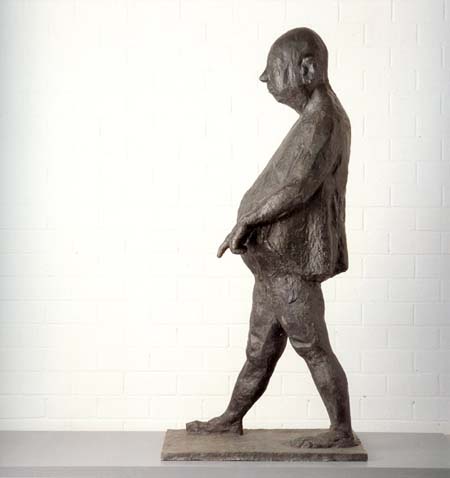
NIG
1995.01.0018. Hombre andando en la playa. 1953.
170 x 75 x 80. Bronce. |
| |
|
Without a doubt, Pablo Serrano is one of the most
relevant Spanish artists of the second half of the 20th
century, despite the fact that his presence in the
country's art scene was not too long: from 1955, when he
came back to Spain with a grant given by the Uruguayan
government, to 1985, when he died.
In just a 30-year activity period in Spain, this
sculptor from Crivillén (Teruel) reached great
relevance, supported by his ongoing commitment to art
and Spanish society. It is worth noting that he is the
founding member of the Paso Group and one of the
most active artists, one that publicly expressed his
opinion on the political situation at the time.
Now, on the occasion of his hundredth birthday, a review
of his works is in order, which will surely help us give
him the position he genuinely deserves. |
| |
|
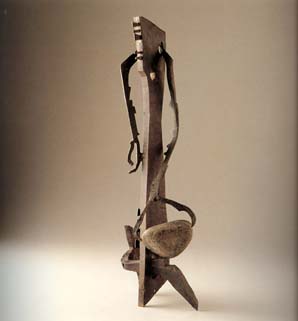
NIG 1995.01.0029. Polifemo. 1956.
46,8 x 16,5 x 15,5 cm.
Hierro
y canto rodado. |
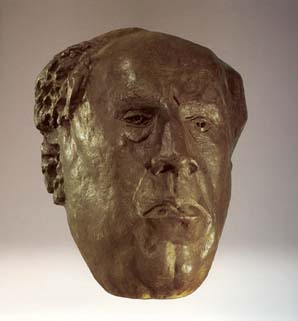
NIG
1995.01.0200. Interpretación al retrato de Antonio
Machado. 1984. 127 x 108 x 123 cm. Bronce. |
| |
|
The exhibition is devised as a tour along the complex
and uncommon evolution of Serrano's art, characterised
by a lack of satisfaction in his line of work which he
considered to have run out at certain times, hence his
search for constant change. We are faced with an
eclectic and rich artistic path based on the command of
work materials and a trade mastered over many years. His
multiple artistic sides –subtly criticised sometimes-
were not exclusive to Pablo Serrano. In fact, more
recent references can be found, like the artist
Gerhard Richter, who also opposed to the phrase “a
piece clearly identifiable with…”.
As in a landmarked track, the exhibition will show us
the footprints left by Pablo in his transitions and
individual redoubts, art pieces being grouped on the
basis of similar theoretical backgrounds showing the
artist's evolution within the same discourse. The works
are presented together with some preparatory sketches
and, in some cases, with manuscripts by Serrano himself
supporting and developing the theories behind the
exhibits. |
| |
|
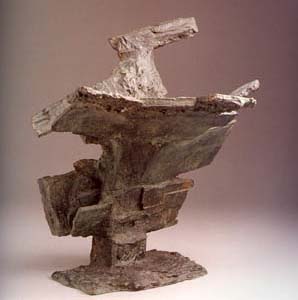
NIG
1995.01.0062. Bóveda para el hombre. 1962-65.
52,3 x 49 x 45 cm. Bronce. |
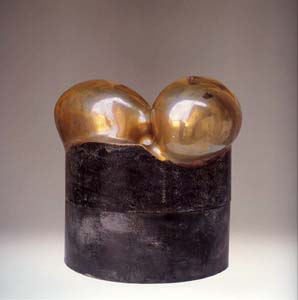
NIG
1995.01.0143. Forma táctil nº 3. 1973. 29,4 x
24,5 x 29 cm. Bronce. |
| |
|
Exhibition:
Hombre andando por la playa
(1953) is the opening piece. This singular sculpture is
the only one which Pablo Serrano initially rescued from
his Uruguay works. For him, it symbolised the
willingness to start a new way and particularly in this
exhibition the outset of the discovery of his own
"footprints" in the artistic way he walked.
The first block groups works already done in Spain
between 1956 and 1959. They are examples from the series
hierros encontrados, ordenación del caos, quema del
objeto and ritmos en el espacio. It includes
11 sculptures and some drawings.
The second block includes pieces from the period
1962-1976 from the series bóvedas para el hombre
(used to represent Spain in the 1962 Venice Biennale),
hombres bóveda, hombres con puerta, lumínicas and
unidades táctiles. It includes 10 bronze works and
some drawings. |
| |
|
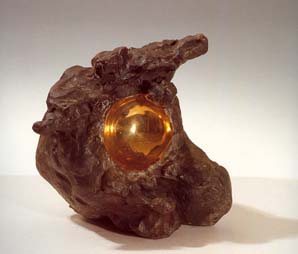
NIG
1995.01.0070. Hombre bóveda. 1963-64. 33,7 x 31,2
x 36 cm. Bronce. |
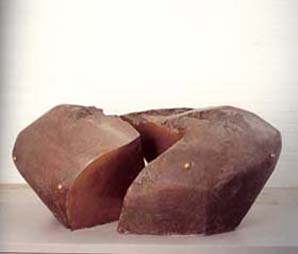
NIG
1995.01.0171. Gran pan partido. 1978. 95,5 x 258
x 108 cm. Bronce. |
| |
|
Unidades yunta
is the third block, composed of 5 bronze and marble
sculptures and drawings.
The fourth group covers Serrano’s figurative references,
which he alternated with abstract works throughout his
career. Undoubtedly, his interpretaciones al retrato
are some of his most interesting pieces if we bear
in mind that his only purpose was to portray his
friends, like Machado, to pay homage to the people he
admired. The portraits of Aranguren, Gaya Nuño,
Alberto Portera, Michel Tapié, Westherdal or
the monumental head of Antonio Machado are the
six pieces that make up this exhibition section.
His approach to or review of the paintings of the great
masters gave way to series like divertimentos en El
Prado or divertimentos con Picasso, la guitarra y
el cubismo. From the first series, the show has
included La Familia de Carlos IV, La Duquesa de Alba,
El Príncipe Baltasar Carlos a caballo, El retrato de
Carlos V, and Retrato de Carlos III cazador.
We cannot overlook Pablo Serrano’s “monumental
sculptures”. The exhibition includes his models made for
the monuments of Unamuno, Galdós, Ponce de León, Juan
March, Labradora turolense and “Encuentro”.
This block is complemented by a clip with recordings of
the monuments on site, to understand the preparatory
work at the studio and the works' final definition in
their actual location.
Another complementary material is a video about
Serrano’s life, which helps contextualise the artist and
his art work. |
| |
|
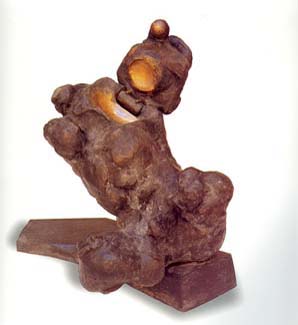
NIG
1995.01.0113. Hombre caído con puerta. 1966-67.
61 x 79,5 x 50,3 cm (cerrada). Bronce. |
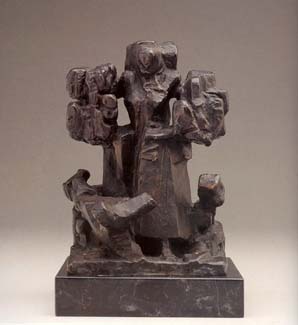
NIG
1995.01.0283. Boceto al Monumento a la Labradora.
1976. 24,5 x 16 x 16 cm. Bronce. |
| |
|
Pablo Serrano. A bibliographical sketch.
Pablo Serrano was born on 10 March 1908. He fist studied
in Zaragoza and then in Barcelona, where he learned
sculpture until he moved to
Montevideo (Uruguay)
in 1939. He spent 25 years there and in Argentina, as a
sculptor.
In
1944, 1951 and 1954
he was awarded the First National Prize of the Salón
de Bellas Artes of Montevideo, for his sculptures.
He returned to Spain after receiving the Award of
Montevideo’s Biennale in 1955. That very year, he also
earned the Sculpture Prize of the Bienal
Hispano-Americana of Barcelona.
His numerous sculptures shifted from neo-figuration to
abstraction. In 1957 he exhibited his figurative works
(portraits) and abstract sculptures (hierros) at
the
Ateneo of Madrid.
His exhibitions then travelled across Europe and
America.
In 1962 he presented 23 works under the title Bóveda
para el hombre at the Spanish Hall of the 31st
Biennale of Venice,
with great success. His works are exhibited at the
Modern Art Museum of New York, Saint Petersburg’s
Ermitage Museum, the Museum of Contemporary Art of
Paris, the Guggenheim, the Gulbenkian Foundation of
Lisbon, the Middelheim Museum of Ambers, the Vatican
Museum, etc.
He died in Madrid on 26 November 1985. He donated his
works to the
Pablo Serrano Museum of
Zaragoza. His heirs, Pablo Bartolomé Serrano
(his son) and Valeria Serrano Spadoni (his
grand-daughter) confirmed the donation. |
| |
|
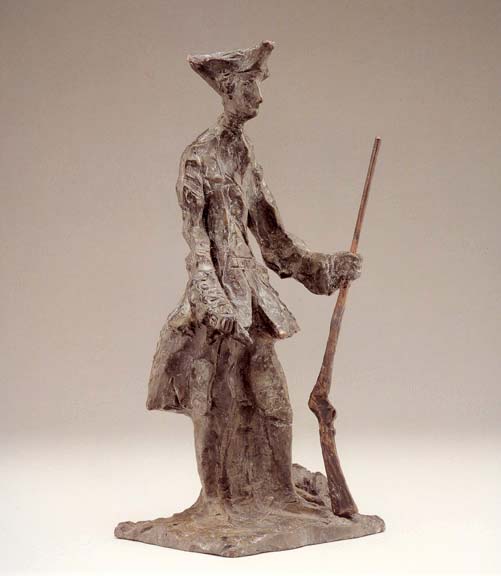
NIG
1995.01.0078. Carlos III. 1974. Serie:
Divertimentos en El Prado. 36,3 x 19 x 15 cm. Bronce. |
| |
|
|